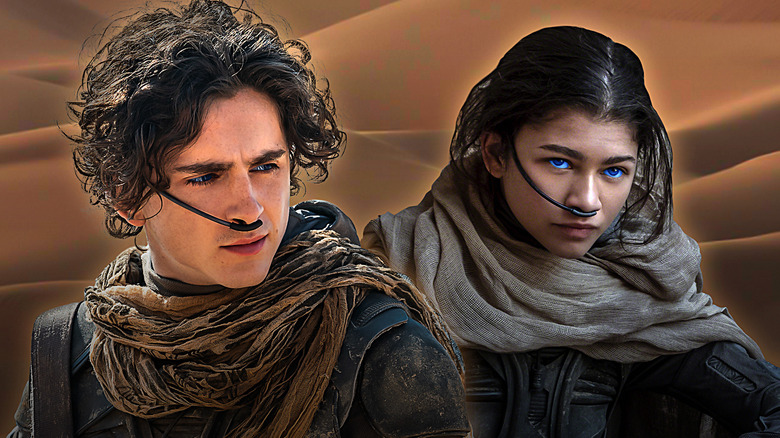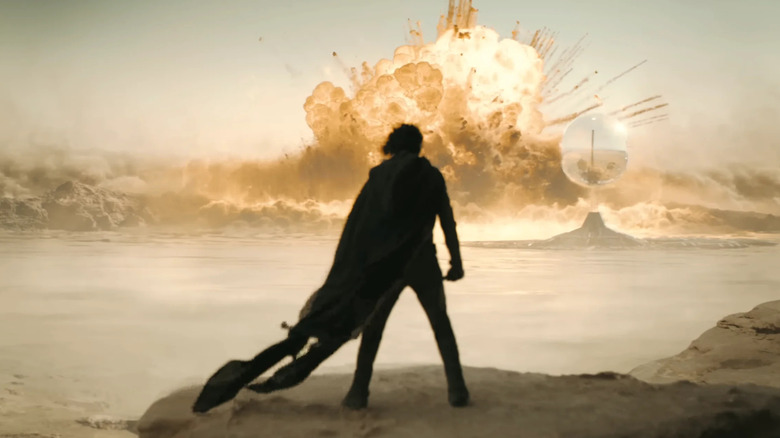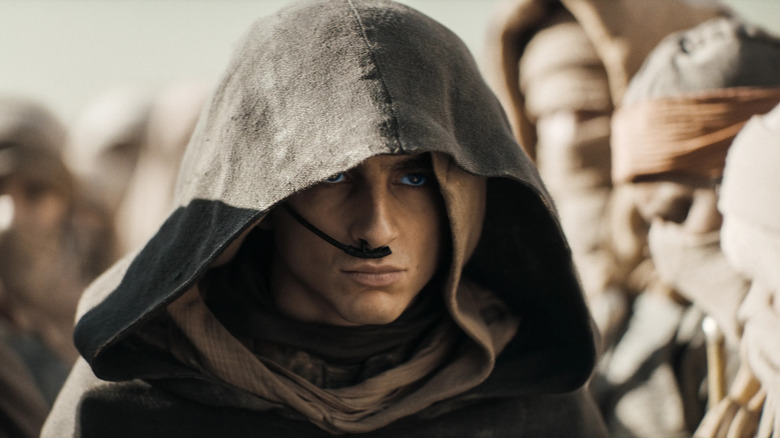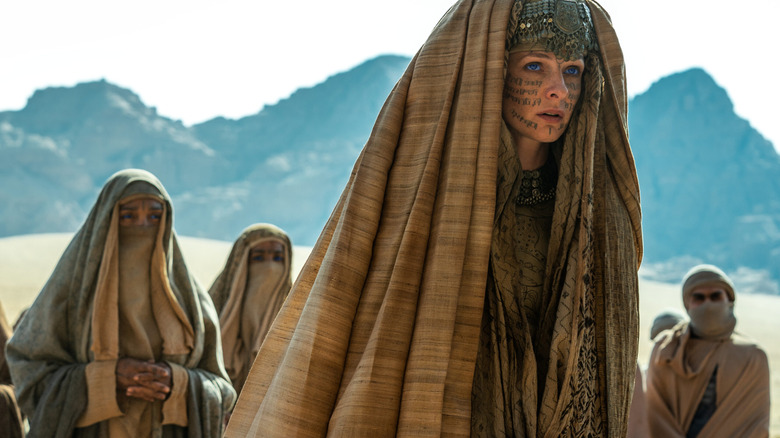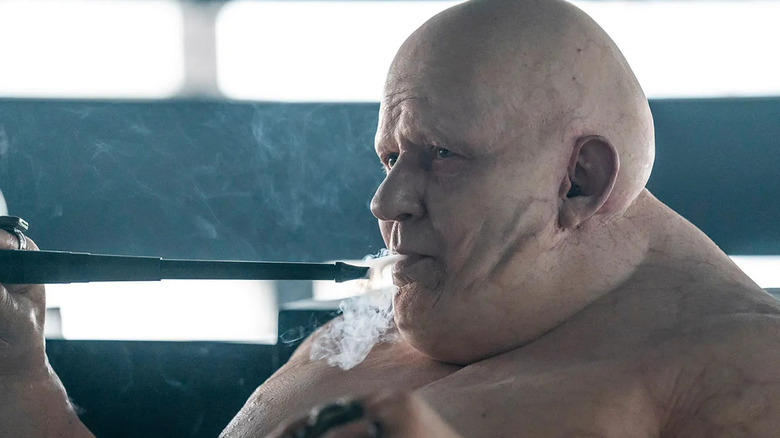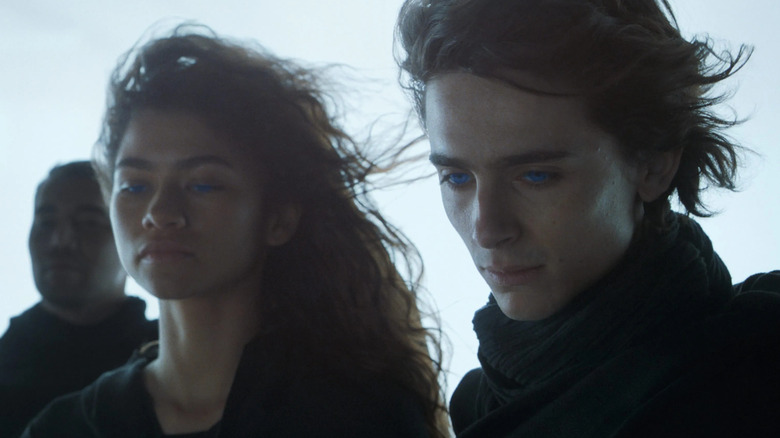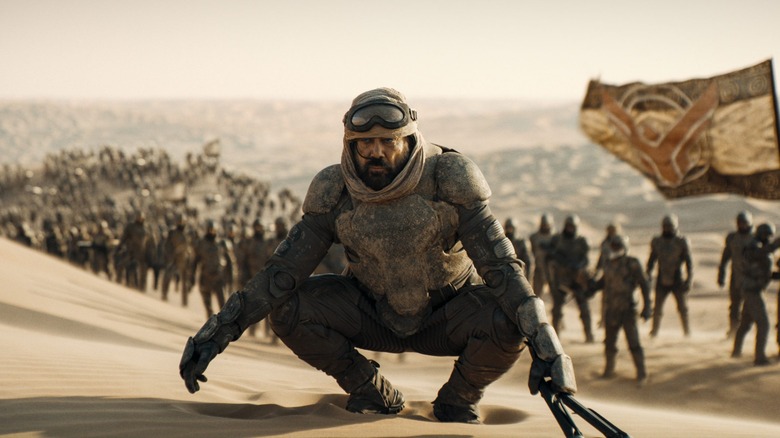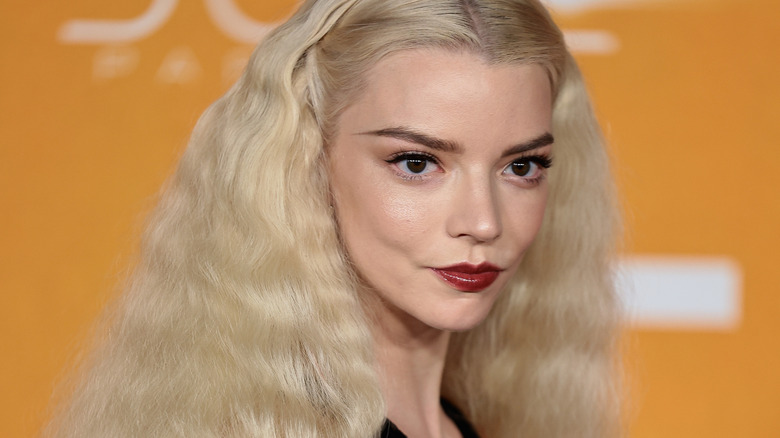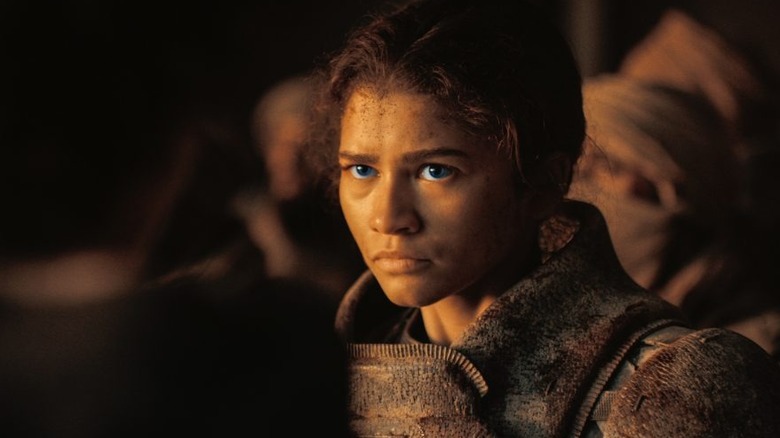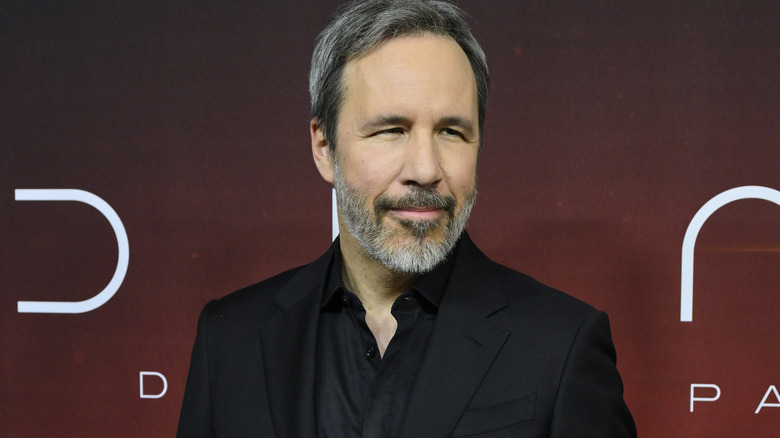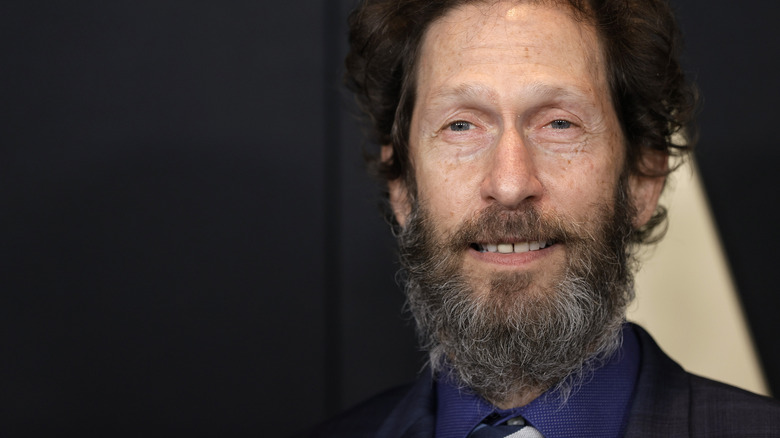The Ending Of Dune: Part Two Explained
Contains spoilers for "Dune: Part Two"
Published in 1965, Frank Herbert's highly influential sci-fi novel "Dune" is set in the far future and revolves around a young aristocrat named Paul Atreides with the power of prescience — he can see things before they happen — who travels with his family from his lush home planet of Caladan to the desert planet of Arrakis (aka Dune). Unfortunately, it's part of an elaborate plot to have his family killed by the evil Harkonnen clan, led by Baron Vladimir Harkonnen. Paul's father Duke Leto is assassinated, but Paul and his pregnant mother Lady Jessica escape into the Arrakian desert and join up with the native Fremen, who are also enemies of the Harkonnens.
The book's success led to a series of "Dune" novels written by Herbert, culminating in 1985's "Chapterhouse: Dune," which was published a year before his passing in 1986. Herbert's son Brian and Kevin James Anderson have collaborated on more "Dune" books as late as 2022. The success of "Dune" also led to multiple filmed adaptations, including the infamous 1984 David Lynch-directed version, the 2000 Sci-Fi Channel miniseries, and — of course — the 2021 big-budget adaptation directed by Denis Villeneuve, with Timothée Chalamet starring as Paul. But the 2021 film only (barely) encompassed the first half of the book, paving the way for 2024's "Dune: Part Two," which picks up right after the first film ends.
What you need to remember about the plot of Dune: Part Two
"Dune: Part Two" begins its story immediately after the end of the first film. Baron Vladimir Harkonnen (Stellan Skarsgård) and his army — with the secret help of Emperor Shaddam IV's (Christopher Walken) elite Sardaukar warriors — have wiped out most of the Atreides, as well as taken over production of the precious substance known as spice on the planet Arrakis.
Meanwhile, Paul Atreides and his mother Lady Jessica (Rebecca Ferguson) — who is currently pregnant with Paul's sister, Alia (voiced by Anya Taylor-Joy) — are led by the Fremen leader Stilgar (Javier Bardem) to a secret warren known as a sietch for safety. This is because Stilgar believes that Paul is the Lisan al Gaib, the Fremen's long-prophesied messiah. Paul is uneasy about this, though, as he's aware that the myth of the Lisan al Gaib was made up centuries earlier by the secretive Bene Gesserit organization. His mother — a Bene Gesserit member — only stokes the myth to her benefit, becoming a Reverend Mother to the Fremen.
Paul then attempts to ingratiate himself with the Fremen, especially the skeptical Chani (Zendaya), eventually earning his place in the tribe by destroying the Baron's spice mining operations and successfully riding a giant sandworm. He earns the name Muad'Dib, and becomes a legend for his leadership and fighting prowess (the Harkonnens don't know he's actually Paul Atreides, who they believe is dead).
What happens at the end of Dune: Part Two?
At the end of "Dune: Part Two" — which is actually the end of the first "Dune" novel — Paul finally succumbs to abusing his messianic stature with the Fremen to control them. For most of the film, Paul actively avoids his put-upon destiny, as he is haunted by visions which signal to him that if he follows that path, it will lead to galactic war and billions of deaths.
However, after Baron Harkonnen's nephew Rabban (Dave Bautista) fails to contain the Fremen, the Baron employs Rabban's even more ruthless brother Feyd-Rautha (Austin Butler) to quell the rebellion. Feyd's cunning and ruthlessness eventually push Paul to accept his persona as Lisan al Gaib in a bid to lead millions of fanatically religious Fremen against the Harkonnens. Paul also challenges Emperor Shaddam IV to show up on Arrakis as well, lest Paul exposes his illegal collaboration with the Harkonnens to wipe out the Atreides.
What unfolds is an epic, explosive battle as Paul unleashes his Fremen followers against the visiting Emperor's army on Arrakis, eventually overwhelming his forces and killing off the remaining Harkonnens. However, Paul leaves Shaddam alive so that he himself can ascend the throne by marrying Shaddam's daughter Princess Irulan (Florence Pugh) — much to the chagrin of his love, Chani. Unfortunately, the rest of the Empire doesn't accept Paul's ascendancy, which leads him to order his Fremen to commandeer spaceships and begin the holy war his visions warned him of.
What the end of Dune: Part Two means
The ending of "Dune: Part Two" is partly a takedown of "white savior" or "white man's burden" stories. These types of stories crassly use their narratives to justify racism, classism, and colonialism. Science fiction as a genre, especially space stories in the early 20th century, can be particularly guilty of this trope, such as Edgar Rice Burroughs' "Princess of Mars" series –- where a Confederate soldier tames the native green-skinned Tharks to do his bidding. In these narratives, a white man will come to a "savage" or "uncivilized" place, making it his "burden" to save the natives from their backward ways.
"Dune" — both Frank Herbert's novel and Denis Villeneuve's films — tackles this uncomfortable trope head-on. The story shows how these types of colonial myths are used as propagandistic justifications for the imperialistic subjugation of other nations under the guise of "helping" them. Furthermore, by making Paul a megalomaniacal tyrant at the end, it warns us how this kind of thinking has led to countless genocides, due to these narratives "othering" cultures that were seen as "lesser" by Eurocentric powers — the way the Fremen are mistreated on Arrakis.
As Herbert said during a talk at UCLA in 1985 (via The Augustry): "I wrote the 'Dune' series because I had this idea that charismatic leaders ought to come with a warning label on their forehead: 'May be dangerous to your health.'"
Dune: Part Two is a biting critique of religion institutions
Frank Herbert may not have necessarily been an atheist, but the "Dune" books are nonetheless still critical of religious institutions, which is made explicit in the film "Dune: Part Two" as well. In both the book and film, the secretive Bene Gesserit — of which Paul's mother, Lady Jessica, is a member — create something centuries earlier called the "Missionaria Protectiva," through which the Bene Gesserit plant fake prophesies and myths around the galaxy to exploit sometime in the future. One of those false prophesies is that of the Lisan al Gaib on Arrakis, which is why part of the myth involves his mother being a Bene Gesserit.
Herbert spells out the problem with religion in the novel "Dune," writing, "Much that was called religion has carried an unconscious attitude of hostility toward life ... the teaching of religion by rules and rote is largely a hoax."
Meanwhile, the film does a great job of showcasing these themes. We see Lady Jessica using the myth firsthand to incite and further radicalize the fundamentalist Fremen in the south of Arrakis as their Reverend Mother, against Paul's wishes. Then, when he finally decides to use the Fremen to his advantage and take his revenge, we see how effective and dangerous those myths are as a tool of colonial control.
A metaphor for modern capitalism
"Dune" is the story of a rare resource that can only be mined in the harsh desert, of which various conniving colonial powers fight for control — even going to the point of all-out war. However, unlike the real world where our rare resources are fossil fuels like oil, the commodity in the sci-fi universe of "Dune" is melange, aka spice. And just how most of the world's oil is mined from the Middle East, spice only exists on Arrakis and is used for interstellar space travel. Unlike oil, spice is not fuel, but it gives the ships' pilots the ability to navigate the cosmos at superhuman speeds.
Frank Herbert makes these real-world connections explicit, as the Western world has been interfering with the Middle East to mine its resources for almost a century and counting. The whole plot of "Dune" is about fighting for control of the spice, and the reason the Harkonnens massacre the Atreides in the first place. This leads Paul to seek revenge and eventually unleash the Fremen on an interstellar jihad that claims billions of lives. In essence, commerce and capitalistic greed are the root cause of all the tragedies in "Dune," and why it inevitably ends the way it does.
Another possible explanation of Dune: Part Two's ending
"Dune: Part Two" — and the "Dune" series as a whole — is also about the philosophical push-pull of fate vs. choice. In "Dune," Paul Atreides (and later his children) has the power of prescience — essentially the ability to see the future. However, Paul can't see the future clearly at first, and is initially only able to perceive flashing fragments and images. For instance, in the 2021 "Dune" film, we see Paul fall in love with Zendaya's Chani because of visions he has on Caladan before arriving on Arrakis. That changes when he inhales the "Water of Life," which opens up his abilities.
Furthermore, Paul can witness the flow of time splintering into multiple possibilities all at once. It's comparable to a crashing ocean wave — you can swim in many, almost infinite, directions at first, but a choice has to be made before the wave of time eventually crashes upon you. However, this begs the question: does Paul freely choose his role as the genocidal Muad'Dib ... or is that always the course he was going to take, with his prescient visions paradoxically leading him to that conclusion?
This is an interesting philosophical debate about the nature of free will and choice, which the story leaves purposely vague. However, it still brings into question Paul's character — if there really is only one path he sees in all the timelines where his revenge succeeds, it is worth galactic genocide?
What the end of Dune: Part Two could mean for the franchise
The ending of "Dune: Part Two" leads straight into the story of the second book, "Dune Messiah" (which will be the third film in a proposed trilogy, since the first book was split into two movies). "Dune Messiah" itself is set 12 years after the first "Dune." Paul (aka Muad'Dib)'s fanatic Fremen army has laid waste to the known universe in a genocidal war, conquering countless planets and sending the death toll into the billions.
Paul is now both a leader and religious figure, the legend of Muad'Dib having spread throughout the universe as someone to be feared and worshiped. And while the galaxy is being torn apart by the Fremen's bloody and merciless jihad, Paul resides comfortably as Emperor on Arrakis with Chani as his mate, even though he is betrothed to Princess Irulan. This leads, of course, to palace intrigue as Irulan — who wants to bear Paul's heir — conspires to have him assassinated. Meanwhile, Paul tries to manipulate his visions so that Chani and his future children can live, despite the conspiracy.
This is all set up in the film "Dune: Part Two." By the end we see Paul become more maniacal (most notably in his speech to the Southern Fremen), we see the romantic rivalry between Chani and Irulan, and finally, we see the chilling sequence of his Fremen army flying to war.
Paul's vision of Alia in the future
One of the biggest changes that "Dune: Part Two" makes to the original book is the exclusion of Paul's younger sister Alia. Alia does appear in the 2024 film as a fetus that talks to her mother, Lady Jessica, who is pregnant with her. But in the book and all other filmed adaptations of "Dune," there's a time jump of a few years where we see Alia being born and walking around as a creepy little girl. In fact, the only time that Alia appears in the flesh in "Dune: Part Two" is during a flash-forward vision where Paul sees her as an adult, played by Anya Taylor-Joy (who also voices her fetus).
This change was probably made by Denis Villeneuve and co-writer Jon Spaihts to condense the story's timeline and give it more urgency. However, this does bring up the question: will there be an even bigger time jump between the "Dune" and "Dune Messiah" films?
The "Dune Messiah" novel is set 12 years after the first book, but with the multiple-year time jump in the first "Dune" book, it's closer to 15 years in total. Anya Taylor-Joy is 27 years old as we write this, so are the filmmakers going to make her play younger (which, admittedly, Taylor could pull off, but perhaps not 15 like Alia is in the book), or will the narrative time jump be more significant in the films?
Chani's possible new role in the sequels
Denis Villeneuve's two "Dune" films are very accurate to the books, especially in terms of their themes and general structure; however, like most adaptations from page to screen, there are changes that have to be made. In this case, Villeneuve and co-writer Jon Spaihts make the film version of Chani aware of "Missionaria Protectiva" — the centuries-old Bene Gesserit plot to create myths that "predict" the coming of a Messiah as a form of cultural control — and has her rebel against it.
This is a major departure from the books, as Chani is a devoted believer in Paul once they fall in love. In fact, after Paul takes Princess Irulan's hand in marriage due to crass political maneuvering, he makes it clear to Irulan that she will not bear any children and that Chani is his romantic partner. This is of course a major departure from Zendaya's portrayal of Chani, who (understandably) runs off in defiance once Paul springs his marriage proposal to Irulan. The film even ends with a close-up of her distraught face.
However, it's unclear how this will affect the upcoming "Dune Messiah" film. That book's plot largely hinges on who will bear Paul's royal heir — Chani, his lover, or Princess Irulan, who is now legally his wife. Is it possible Chani's role as a doting lover will be changed, and that she'll be a more antagonistic figure in the sequel? Only time will tell.
What has the cast and crew of Dune: Part Two said about the ending?
Director and co-writer Denis Villeneuve has talked about the ending of "Dune: Part Two," specifically how it closes on a cliffhanger. While the film's final sequence ends similarly to the way it does in the novel, there are some key differences. For instance, while Paul has dreams (or rather, nightmares) about an upcoming holy war that'll happen once he becomes Emperor, we don't watch it come to pass as we do in the film. However, in "Dune: Part Two," after Paul receives word that the other major houses in the Imperium won't support his ascension to the throne, we witness Stilgar lead the Fremen toward the ships to attack.
Here's what Villeneuve said about the rather downbeat ending in an interview with Vanity Fair: "The 'Dune' book ends with the beginning of something that is out of control, and I thought this was a very powerful ending." He also states his desire to direct a film version of "Dune Messiah" at some point, which will drive the point home about "the end of the arc of Paul Atreides" — essentially his rise and tragic downfall (though anyone who has read "Children of Dune" knows that's not entirely accurate). It also seems likely that Villeneuve won't direct any later books, telling Entertainment Weekly that they are too "psychedelic, so I don't know how some of them could be adapted."
Dune: Part Two's alternate ending
"Dune: Part Two" is indeed a long film – director Denis Villeneuve has even insisted that films should be longer in general – but there are still things left on the cutting room floor regardless. This includes entire characters and subplots that were completely excised from the film. Among these was a character played by renowned actor Tim Blake Nelson, who was officially cast in the film, but who doesn't show up at all in the finished cut.
While currently unconfirmed as of this writing, there are nonetheless persistent rumors that Nelson was set to portray Count Hasimir Fenring, due to his physical appearance matching that of the character in the book. The Count himself is a deadly assassin and trusted friend of Emperor Shaddam IV. He is also a failed Kwisatz Haderach hopeful, due to being a eunuch. At the end of the book, he is ordered to kill Paul after Paul defeats Feyd-Rautha, but refuses.
His deleted appearance is further evidenced by the fact that Léa Seydoux plays the character of Lady Margot Fenring, the wife of Count Fenring. In the film, she's the Bene Gesserit who watches Feyd-Rautha fight in the arena on the Harkonnen home planet of Giedi Prime, and later seduces him to control him for her order. Her inclusion, while not outright confirming the existence of Count Fenring, does at least lead credence to it — and to a possible ending that Villeneuve chose to discard.
